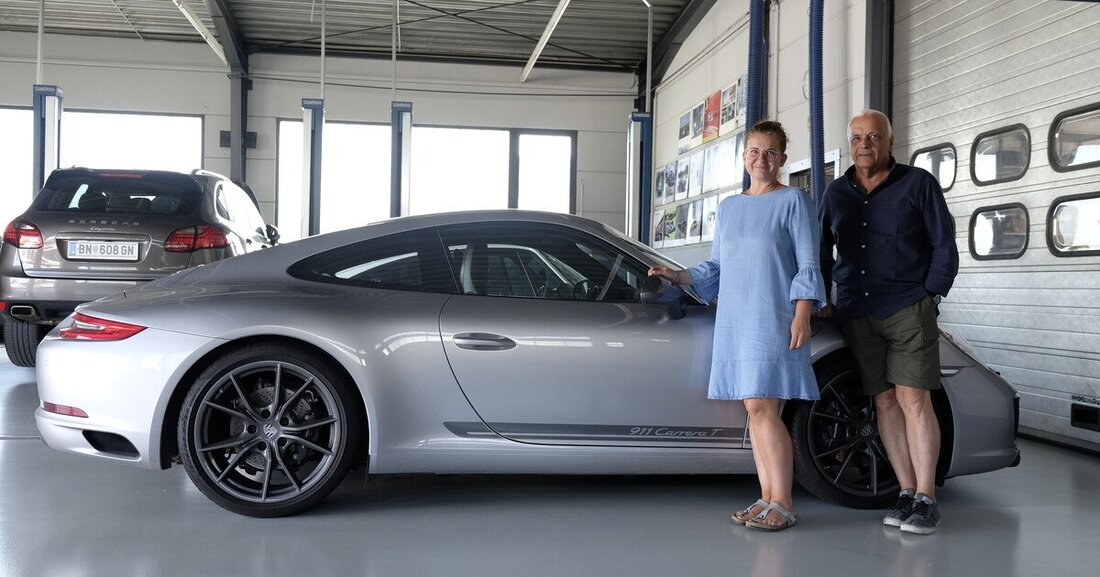Porsche 911: defect in the key
A 13-year-old Porsche 911 ends up in Josef Barbach's workshop with an unusual problem: the comfort functions individually programmed in the vehicle key are going crazy.

Porsche 911: defect in the key

© Peter Seipel / ÖWV
In the higher equipment variants of the Porsche 997, which is the internal model name for the 911 produced from 2004 to the end of 2012, the seating position, steering wheel height, mirror setting and even the radio station can be adjusted to the needs and personal taste of the driver via vehicle key programming. The settings are made automatically when you unlock it - provided the system works as it should. But the 997, which one day ends up in the workshop of the Porsche specialist Josef Barbach in Bad Vöslau, stubbornly refuses to follow the programmed control commands and puts the seats, mirrors and steering wheel in a position that requires the driver - to put it to say the least - to make acrobatic contortions when taking a seat. The settings can be easily corrected manually, but the laborious procedure is repeated every time the sports car is restarted. Since the 911 had only recently been purchased as a used car, its new owner took it back to the dealer. He tries to solve the problem in the in-house workshop. When he doesn't succeed, he takes the sports car to Josef Barbach, a master car master who specializes in the traditional German brand and runs an independent workshop in Bad Vöslau. A diagnostic crime thriller begins.
- Erstdiagnose: Der Porsche ist mit zwei Schlüsseln ausgestattet, die nach den Vorlieben verschiedener Lenker individuell programmiert werden können. Doch beim Aufsperren mit Schlüssel 1 fährt der Sitz automatisch weit nach vorne und muss vom Lenker vor dem Einsteigen per Knopfdruck in die passende Position nach hinten gefahren werden. Beim Aufsperren mit Schlüssel 2 passiert das Gegenteil – der Sitz fährt weit zurück und muss manuell nach vorne gefahren werden.
- Der Kfz Meister versucht mehrmals, die Schlüssel nach den Vorschriften der Bedienungsanleitung neu zu programmieren. Er steckt Schlüssel 1 in das Zündschloss, stellt manuell die gewünschte Sitz-, Lenkrad- und Spiegelposition ein und drückt gleichzeitig die Memory- und Schlüsseltasten in der Türverkleidung. Fazit: Die falschen Einstellungen bleiben erhalten.
- Das Diagnosegerät wird angeschlossen, der Fehlerspeicher ausgelesen – kein Fehler wird angezeigt. Der naheliegende Verdacht: Ein Karosseriesteuergerät ist defekt und muss getauscht werden.
- Josef Barbachs Tochter Helga, die im Familienbetrieb mitarbeitet, wagt zuvor noch einen Versuch. Mit Schlüssel 1 im Zündschloss programmiert sie den Fahrersitz auf die vorderste, mit Schlüssel 2 auf die hinterste Position. Dabei stellt sich heraus, dass der Sitz nach dem Aufsperren mit beiden Schlüsseln in genau die gegenteilige als die einprogrammierte Position fährt.
- Helga Barbach findet dafür die einzig logische Erklärung: Die Schlüsselelektronik muss vertauscht worden sein. Die kleine Platine wird beim Batteriewechsel aus dem Schlüssel genommen, und wenn dies bei beiden Schlüsseln zugleich gemacht wird, kann es passieren, dass die Platinen danach verkehrt wieder eingesetzt werden. Helga Barbach tauscht kurzerhand die Platinen aus, das Problem ist behoben, der Fall gelöst.
Comment: Comfort comes first
Unfortunately, only a few repair cases involving vehicle electronics are as easy to solve as the current diagnostic mystery. In luxury class vehicles, functions such as vehicle lighting, windshield wipers, immobilizer, remote control key, climate control, automatic start-stop or tire pressure monitoring are managed by several body control units. These communicate with each other and also with the electronic components via a BUS system. Since this complex network does not make it easier to find a possible error, a current trend in vehicle development is towards a single central body control unit. The advantage: This could process a much larger amount of data much more quickly and save cable harnesses and weight. The BUS systems commonly used today such as CAN, FlexRay, LIN or MOST are to be replaced by the powerful Ethernet, which allows a data transfer volume of 100 Mbit/s between the nodes of the network. We can only hope that the new, powerful on-board computers will also be adequately protected against hacker attacks.

 Suche
Suche
 Mein Konto
Mein Konto